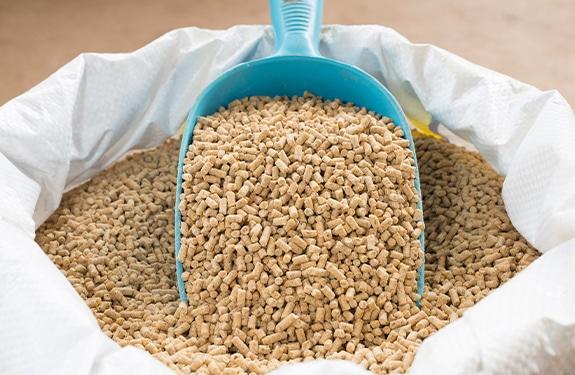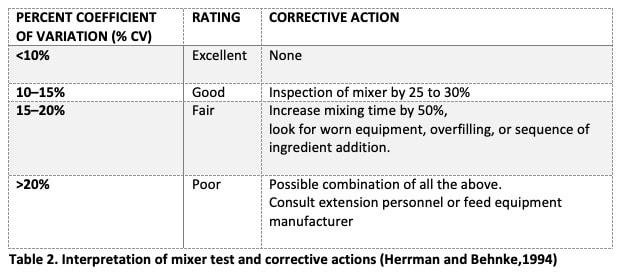Mixing: guidelines for quality feed production ensuring better animal performance
Published: August 11, 2020
By: Mohamed MAMMERI, PhD, Global Product Manager, Phileo by Lesaffre & Cécile Sampsonis, PhD, Products Formulation Manager, Phileo by Lesaffre.

Phileo is constantly working to improve its range of yeast probiotics, giving farmers and companion animal keepers effective and consistent products, backed by extensive trials evidence and practical user experience. The company is also committed to making sure all its probiotics are handled properly during the feed production process, maintaining their power and effectiveness through to their eventual use. This includes advising on mixing procedures according to feed manufacturing guidelines devised by Phileo’s Feed tech Service.
“Feed production technologies have progressed greatly in recent years, evolving from the simple mixing of several ingredients, through different mechanical and continuous methods, to the computer-controlled mixing and pelleting systems which are used today,” said Phileo feed technologist, Alix Hemdane.
Despite such advances, the basic concept of mixing ingredients together to create a nutritionally balanced feed, remains largely unchanged. In fact, the science of mixing is extremely complex, and the challenge is to produce a homogeneous and standardized diet for optimal and consistent animal performance.
This is the industry background against which Feed tech Service has developed tailor-made advice on all aspects of pellet manufacturing, including giving detailed guidance on the best mixing procedures to use to achieve a homogenous diet for better animal performance.
Ensuring uniform mixing to achieve homogenous feed
Mixing different ingredients by grinding each to a similar particle size, and then combining the prepared particles within a single unit, requires a considerable amount of specialist equipment and high-level technical expertise.
While feed plants differ according to function, with some making one dedicated product and others handling a variety of feeds, the basic raw material flow remains much the same across the industry. Similarly, the common challenge for plant operators is to produce a nutritionally balanced feed, ensuring that the final product, when fed to animals, imparts both health and performance benefits.
Indicator methods for assessing mixing quality
Many factors influence the mixability of a feed product, making it vital to know the extent to which a feed mixture has been properly handled in terms of homogeneity. To confirm the diet is homogenized, samples can be taken from the mixer to test for uniformity. Assessing mixing homogeneity by taking a chemical measure of vitamin levels or trace elements is also possible, although both these approaches are time consuming and expensive.
Alternatively, using indicators to assess mixing homogeneity is a much more economic and time efficient solution, compared with analysing each individual nutrient. The selected indicators will, preferably, have the same physical properties as the feed ingredients which are being tested. Tracers such as sodium, chloride, coloured iron particles, lysine, methionine, chromium, zinc, manganese, and copper, have all been used as indicators in assessing mixing uniformity.
Coefficient of variation as indicator of mixing homogeneity
Various statistical methods are available to calculate the degree of homogeneity when using an indicator in the testing process. To assess the mixing homogeneity of a key component, for instance, samples will usually be taken from random locations within the mixer or collected at regular intervals from the discharge outlet.

Herrman and Behnke (1994) categorized mixer tests as excellent, good, fair, and poor, based on % CV ranges. The corrective actions of these categories are presented in the table below.
A homogenized diet is considered to have been adequately mixed when the CV is less than 10%. To achieve the best testing results, each mixer should be calibrated for its mixing time and capacity by volume.
Key points and practices for accurate mixing:
- Add large-volume ingredients first, then smaller-volume items.
- Unless already premixed, liquids should be added after all dry ingredients have been mixed.
- Avoid under and over mixing by ensuring mixer’s calibration, taking account of total mixing time and formula composition.
- Mixer uniformity should be tested twice a year.
Mixing uniformity: ensuring homogenous diet for better animal health and performance

It is critical that animals receive a properly homogenized diet, as originally formulated by the nutritionist. This ensures that the full health and performance benefits of the feed reaches the target animal exactly as intended. To achieve this, nutritionists and feed plant operators must work closely together on everything from processing and storage techniques, and the adequate maintenance of plant equipment, through to the monitoring of feed preparations and the routine testing of the final product. Only then will the best results be secured, optimizing animal performance and maximizing production efficiency.
References available on request
Herrman, T. and K. C. Behnke. 1994. Testing Mixer Performance. Kansas State University Extension Bulletin, MF-1172.
Related topics:
Authors:
Phileo by Lesaffre
Influencers who recommended :
Oyedele Oyewumi, Clara BergerRecommend
Comment
Share
19 de julio de 2022
what is the nutritional requirement for various poultry in the farm?
how best can i mix feeds to get maximum profits?
what is the parentage of various feeds at each level?
Recommend
Reply
AGI - Ag Growth International
5 de noviembre de 2020
Good day Mohamed,
Thank you for your article. Although Dr. Benke was my professor at KSU and I respect him highly, I personally consider his "EXCELLENT & GOOD" ratings in the 1994 chart based on the percentage of the coefficient of variation is not accurate anymore and this should be re-evaluated.
With today's technology and variety of mixing equipment, an "EXCELLENT" CV in the feed milling industry is considered equal or below 5%. 10-15% CV is not considered good anymore, even if the diets are for bovines, big species, hogs, etc., The mixing efficiency or CV has to be equal or below 5%, which could be achieved with different types of mixers (single or double-shaft paddle mixers, some ribbon-paddle mixers, etc.).
If you have questions please contact me at any time.
Congratulations to ENGORMIX, your web portal is doing an excellent job to the Agri-Business industries at worldwide level !!!
Giuseppe Bigliani
giuseppe.bigliani@aggrowth.com
Recommend
Reply
7 de octubre de 2020
Thank you for sharing about animal feed process.
I will be even more graceful if you can highlight me:
For an academic trial, I want to add essential oil to rabbit feed.
As i'm experimenting different methods to protect and stabilize my essentiel oil, I don't know how to determine the minimal amount of additive I should prepare to obtain a decent homogenity on my rabbit pelleted feed.
Recommend
Reply


North American Renderers Association (NARA)
NARA advocates for a sustainable food chain, public health and the environment through the production and marketing of our members’ products and services.
Suggested link

Would you like to discuss another topic? Create a new post to engage with experts in the community.







